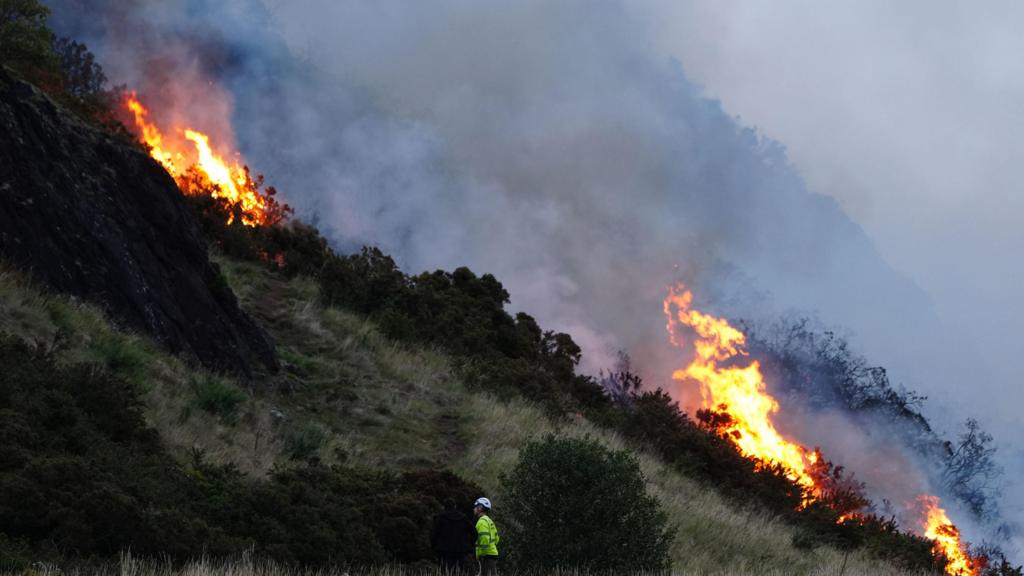As climate change drives temperatures upward, cities across the United Kingdom face an escalating threat from a newly identified phenomenon termed “firewaves,” scientists have warned.
Coined by researchers at Imperial College London, the term “firewave” describes the occurrence of multiple urban wildfires sparked by prolonged periods of hot, dry weather.
This warning comes as firefighters recently combatted three separate heath fires in London and a significant gorse fire on Arthur’s Seat in Edinburgh, with the summer’s latest heatwave leaving vegetation dangerously parched in both capitals.
These incidents, though now contained, underscore the increasing vulnerability of urban areas to wildfires – a hazard previously considered primarily a rural concern.
Guillermo Rein, a professor of fire science at Imperial College London, is collaborating with the London Fire Brigade to help predict conditions conducive to a “firewave.”
Based on current forecasts, he suggests London could face renewed risk by the coming weekend.
London Fire Brigade Assistant Commissioner Tom Goodall expressed support for research aiding in wildfire prediction.
He affirmed that the service is “ready to tackle the threat of wildfires head-on to help protect London’s communities and green spaces.”
Professor Rein’s research indicates that after ten consecutive days of very dry weather, vegetation across wide areas becomes so desiccated that the likelihood of simultaneous fire ignitions increases sharply.
By analyzing detailed incident data from the London Fire Brigade dating back to 2009, alongside weather records, the team identified key factors driving wildfire outbreaks in London.
One crucial factor is the “vapour pressure deficit,” which measures the atmosphere’s capacity to draw moisture from the land.
A higher deficit correlates with drier vegetation, increasing its flammability.
“Vegetation doesn’t just become a bit more flammable,” Professor Rein explained, “it becomes much more flammable.”
He added, “Once the moisture content of the vegetation drops below a certain threshold, even a small spark can lead to a fast-spreading fire.”
While most fires are human-caused, whether accidental or intentional, a warming climate creates conditions more favorable for these blazes.
“Climate change is bringing more heatwaves and longer dry spells,” Professor Rein stated.
“These conditions dry out fuels and increase the risk of wildfires. That risk is much greater now than it was even a decade ago.”
While the research primarily focused on London, concerns are widespread.
“I worry about all other UK cities and other northern European cities in particular because climate change seems to be making green vegetation that was not flammable very flammable indeed,” Professor Rein cautioned.
“And these places don’t have a history of dealing with wildfires so don’t have as much institutional experience as cities in the south of the continent.”
Urban environments such as London, characterized by abundant parks and green spaces bordering residential areas, are particularly vulnerable.
The “firewave” concept underscores the unique danger when multiple fires ignite simultaneously in densely populated areas, potentially overwhelming emergency services and endangering homes and infrastructure.
This scenario occurred in the summer of 2022, when UK temperatures surpassed 40°C for the first time on record.
On July 19, 2022, the London Fire Brigade (LFB) experienced its busiest day since World War II.
Simultaneous fires erupted across the city, including a devastating blaze in Wennington, East London, which destroyed 37 buildings, five cars, and forced the evacuation of 88 homes.
Blake Betts, a borough commander with the LFB, possesses extensive experience in managing wildfires in urban settings.
He emphasizes the significant threat these fires pose, especially when open spaces adjoin residential properties.
“The potential for fires to spread into homes is very real,” Commander Betts stated.
“We’re seeing more extreme weather events, and that’s why the London Fire Brigade has adopted a much more proactive approach.”
To address this growing challenge, the LFB reports investing in new technologies and equipment.
Drones now play a crucial role in wildfire response, providing real-time aerial views that assist commanders in mapping fire spread and allocating resources effectively.
“The bird’s-eye view from drones gives us a huge boost in situational awareness,” a spokesperson from the LFB explained.
“It allows us to target our efforts where the risk to life and property is greatest.”
In addition to drones, the brigade has introduced off-road vehicles capable of accessing fires in challenging terrain, such as heathland and grassland.
These vehicles can create firebreaks by using water to saturate the ground, impeding further fire spread.
The Imperial College London researchers argue that the Met Office’s current definition of a heatwave does not adequately represent wildfire risk in urban areas.
They propose adopting the term “firewave” to signal periods of extreme fire danger in cities, hoping it will inform future public safety strategies and climate resilience planning.
The Met Office has been asked for comment.
Sign up for our Future Earth newsletter to keep up with the latest climate and environment stories with the BBC’s Justin Rowlatt. Outside the UK? Sign up to our international newsletter here.
One Wiltshire wheat farmer says yields are so bad, his farm may not make any money this year.
How dangerous is UV radiation and how can you protect yourself when levels are high?
Blue-green algae has been detected almost 100 times across Northern Ireland since the start of 2025.
An academic says the UK treats the heat as “a nice thing” but it needs to be treated as a risk.
The UK’s seas have had their warmest first seven months of the year on average since records began.

